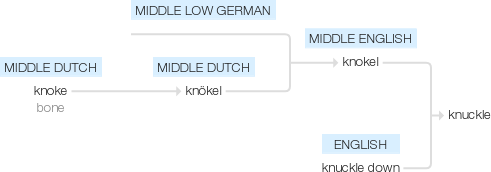Knuckle
Middle English knokel (originally denoting the rounded shape when a joint such as the elbow or knee is bent), from Middle Low German, Middle Dutch knökel, diminutive of knoke ‘bone’. In the mid 18th century the verb knuckle (down) expressed setting the knuckles down to shoot the taw in a game of marbles, hence the notion of applying oneself with concentration.
wiktionary
From Middle English knokel(“finger joint”), from Old English cnucel(“the juncture of two bones; knuckle; joint”), from Proto-West Germanic *knukil, from Proto-Germanic *knukilaz(“knuckle, knot, bump”), as *knukô(“bone, joint”) + *-ilaz(diminutive suffix). Cognate with Dutch knokkel(“knuckle”), Low German Knökel(“knuckle”), German Knöchel(“ankle, knuckle”), Old Norse knykill.
etymonline
knuckle (n.)
mid-14c., knokel "finger joint; any joint of the body, especially a knobby one; morbid lump or swelling." Perhaps in Old English, but not attested there. Common Germanic (compare Middle Low German knökel, Middle Dutch cnockel, German knöchel), literally "little bone," a diminutive of Proto-Germanic root *knuk- "bone," which is not represented in English in its simple form (but compare German Knochen "bone). For pronunciation, see kn-.
knuckle (v.)
1740, from knuckle (n.), originally in the game of marbles (putting a knuckle on the ground is the hand position preliminary to shooting). To knuckle down "apply oneself earnestly" is 1864 in American English, an extended sense from marbles; to knuckle under "submit, give in" is first recorded 1740, supposedly from the former more general sense of "knuckle" and here meaning "knee," hence "to kneel."
